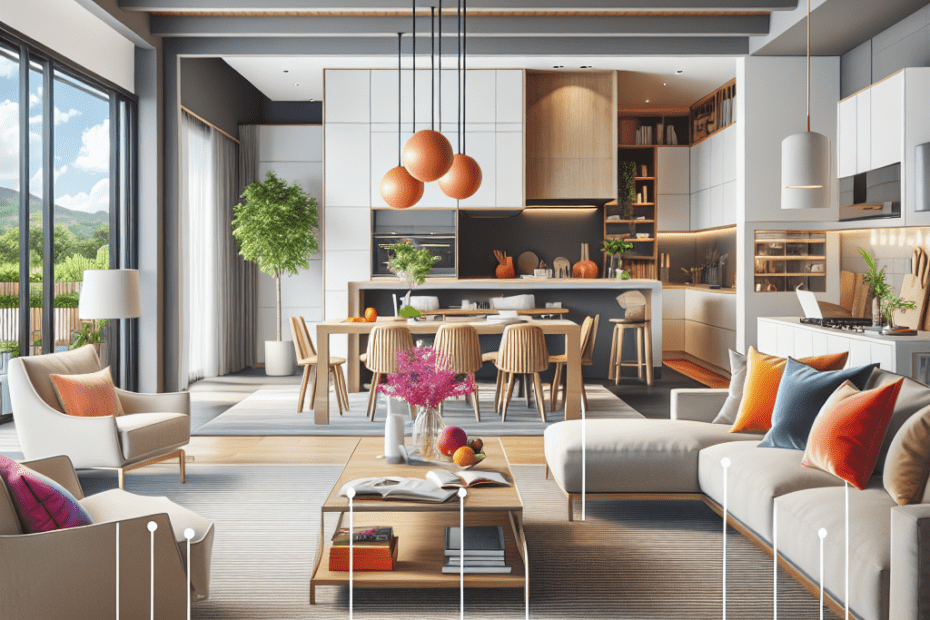Enhancing Open-Concept Homes with Color Accents
In a world where open-concept homes are becoming increasingly popular, homeowners often face the challenge of defining spaces without using physical boundaries. One effective and elegant solution is the use of color accents. By strategically applying different colors, they can effectively create distinct areas within their open-layout homes. Color accents add vibrancy while preserving the spacious and fluid feeling of the environment.
The Power of Color Accents in Open-Concept Homes
Color accents hold the power to transform spaces dramatically. In open-concept living environments, they act as visual cues that designate different areas, such as living, dining, and kitchen zones, without resorting to walls. This method of division plays an essential role in maintaining the openness that makes these homes appealing. A study by Color Research & Application has shown that color can directly influence mood and space perception, making it a crucial element in interior design.
Strategic Application of Color Accents
To successfully use color accents, homeowners should first select a cohesive color palette. This ensures the colors complement each other and flow seamlessly throughout the open space. Popular choices for accent colors include vibrant hues like turquoise or burnt orange, which contrast pleasantly with neutral backgrounds.
- Living Area: Applying a bold-colored sofa or statement rug can effectively mark the living room area.
- Dining Area: Consider using a striking light fixture or an accent wall painted in an eye-catching color.
- Kitchen Area: Bright colored backsplashes or island cabinetry can impart individuality to the space.
Color Psychology and Open Spaces
Choosing the right color accents requires understanding the psychology behind colors. Colors can evoke emotions and set the overall ambiance of the space. Blues and greens are generally calming and are ideal for spaces meant for relaxation, such as the living room. Warmer colors like reds and yellows can energize and stimulate conversation, making them suitable for the dining area. According to Canva’s color psychology, these perceptions are nearly universal and can be effectively used to define and enhance open layouts.
Case Study: A Practical Application
To illustrate the impact of color accents, consider a family in Portland who successfully defined their open-concept home with strategic use of color. They selected a palette of cool tones for a calming effect and highlighted different zones using complementary bold colors. For the living area, they added navy blue cushions and a turquoise throw, subtly designating the space. An orange pendant light marked the dining section, creating a cozy dining atmosphere. The kitchen featured lime green backsplash tiles that distinguished it from the rest of the space.
Benefits of Using Color Accents
With color accents, homeowners gain the flexibility to redefine spaces easily as needs change. It is a budget-friendly approach compared to architectural modifications and allows personalization. A survey by the American Lighting Association revealed that 73% of homeowners felt more satisfaction with their homes after incorporating accent colors.
Challenges and Solutions
While using color accents offers immense aesthetic value, it may present some challenges. Finding a balanced color scheme requires careful planning. Using a color wheel can help in selecting complementing and contrasting colors. Additionally, regularly changing trends can pressure homeowners, but opting for timeless hues can mitigate this issue.
Conclusion
Color accents in open-concept homes empower homeowners to personalize and define their living spaces without losing the openness that characterizes such designs. The right use of color can enhance mood, create distinct areas, and offer a satisfying living experience. As open-concept living continues to rise in popularity, mastering the art of color accents will remain an invaluable skill.
Key Takeaways
- Color accents effectively define spaces in open-concept homes.
- Understanding color psychology is crucial for effective implementation.
- A cohesive color palette ensures harmony and continuity.
- Choosing timeless colors can protect against changing trends.
- Flexibility and personalization are key benefits of using color accents.
Color Accent Ideas Table
| Area | Suggested Color Accents |
|---|---|
| Living Room | Navy Blue Cushions, Turquoise Throws |
| Dining Room | Orange Pendant Lights |
| Kitchen | Lime Green Backsplash |
FAQ
- What is an open-concept home?
An open-concept home is a layout that minimizes the use of walls to separate different functional areas within the home.
- Why are color accents important in open-concept homes?
Color accents help define and distinguish different areas within an open space without the use of physical dividers.
- How do you choose the right color accents?
Choose a cohesive palette that complements each zone, keeping in mind the psychological effects of each color.
- Can color accents be changed easily?
Yes, one of the benefits of using color accents is the flexibility to easily change them as trends or personal preferences evolve.
- What are some potential mistakes to avoid?
Common mistakes include overusing too many bold colors or selecting clashing hues that disrupt the harmony of the space.
